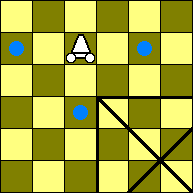Joko Urtaroak
a great chess game of the four seasons
by Glenn Overby
Introduction
Joko Urtaroak is a four-player great chess variant. It was designed for two competitions:
- The Chess Variant Pages' 7th anniversary contest for games played on a board of 84 spaces.
- The annual Arts and Sciences competition of the Middle Kingdom, Society for Creative Anachronism.
The game is a great chess version of Acedrex de los Quatros Tiempos (Chess of the Four Seasons), found in the book of games commissioned by King Alfonso X of Castile in 1283. In addition to a larger board (10 by 10, minus the 16 central squares marked for an unknown purpose in the original), it incorporates two new pieces from other games likely found in Islamic Spain and transforms the move of one other piece. Players still start in the four corners, with Green, Red, Black, and White representing Spring, Summer, Autumn, and Winter.
Setup

GREEN: Pawns a4, b4, d1, d2; Engines b3, c2; Bishop c3;
Gryphon b2; Knight a3; Rook c1; King a1.
RED: Pawns g1, g2, i4, j4; Engines h2, i3; Bishop h3;
Gryphon i2; Knight h1; Rook j3; King j1.
BLACK: Pawns g9, g10, i7, j7; Engines h9, i8; Bishop h8;
Gryphon i9; Knight j8; Rook h10; King j10.
WHITE: Pawns a7, b7, d9, d10; Engines b8, c9; Bishop c8;
Gryphon b9; Knight c10; Rook a8; King a10.
Fonts by David Howe (Alfaerie)
and Armando Hernandez Marroquin (Chess Alfonso-X).
Size manipulations by Glenn Overby.
Pieces
The King, Knight, and Rook all have their modern moves, unchanged over the centuries. There is no equivalent of castling.
The four Pawns also move as they do today, but without a double-step on the first move. (Thus, there is no en passant capture.) Each pair of Pawns treats the expected direction as forward. Promotion occurs on the tenth rank. A Pawn may promote to Gryphon, Knight, or Rook.
The Bishop has its modern move, quite a while before it changed historically. But the unlimited diagonal move is not unknown in 1350 or so. It was used for the Courier in German courier chess, and the Dabbabah in one form of Shatranj Kamil, in the 13th century or earlier. With the central squares blocked in this game, the bishop needs more than its classic two-square diagonal leap. The new move allows teaming up with the two war engines to cover all squares.
The two War Engines are the Dabbabahs of Tamerlane's Chess, a contemporary Persian great chess derived from Shatranj. They move exactly two squares orthogonally, leaping over any intervening piece.

The Gryphon or griffion comes from Grande Acedrex, a large chess variant also found in the Alfonso X manuscript. It moves one square diagonally, and may then continue outward for any number of unobstructed horizontal or vertical squares. The Gryphon cannot leap.

Rules
Joko Urtaroak is played like orthodox chess with an odd board and pieces. The rules differences are:
- Green plays first, then Red, then Black, then White.
- The 16 central squares may not be entered.
- Promotion occurs on the tenth row, relative to that Pawn's direction of travel. A Pawn may promote to Gryphon, Knight, or Rook.
- The first player to score checkmate or to capture an opposing King wins. If a player is stalemated, the other three players draw.
Notes
I have been active off-and-on in the Society for Creative Anachronism, or SCA, for about 10 years. The SCA is dedicated to study and selective re-creation of multiple aspects of pre-17th century Western culture. A wide range of period arts and sciences, including gaming, are practiced.
In addition to learning, playing, and teaching authentic old games, I design new games for use in the SCA. These explore concepts which are documented in period, putting them together in interesting ways which still retain the feel of a certain place and time. Joko Urtaroak is such a game.
The hypothetical origin of Joko Urtaroak is 14th century Iberia. (The name is Basque.) The original game which has been upsized in a Great Chess style can be documented to Castile in 1283, as can the added Gryphon.
The War Engine with its Joko Urtaroak move can be documented to the 1300s in Persia and elsewhere. Pieces with the modern bishop-move can be documented in the 10th century in Islamic lands and the 13th century in Germany.
Other period examples of Great Chess include Grande Acedrex, Courier Chess, and Tamerlane's Chess (all derived from Shatranj), and Chu Shogi (derived from Japanese chess).
Playing Tips
The relative values of the pieces are close to those of orthodox chess. A War Engine is worth about two Pawns, the Bishop and Knight both around three (but with the Knight slightly better than the Bishop), the Rook near five, and the Gryphon at a bit over eight.
Attack the player who follows you. The Gryphon and Rook, the two most powerful pieces, are set up to bear down on that player's King. When you deliver the knockout blow, no other player will have an intervening turn to stop you.
The Bishop and War Engines cover the squares of both colors between them, though each is color-bound. They tend to be most useful on defense until late in the game.
The Knight should not be committed too quickly. It often plays important roles in both attack and defense according to need.
Computer Play
If you have Zillions of Games installed on your computer, you can play this game. Download file: jokourtaroakzog.zip.
Copyright © 2002 by Glenn E. Overby II. This is an entry in a contest of The Chess Variant Pages, and is used there by permission. All rights reserved.
Written by Glenn Overby II.
WWW page created: September 23, 2002.